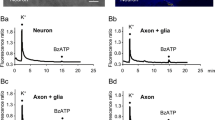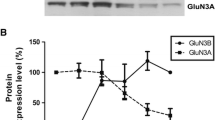Abstract
In order to further analyze the development of glutamatergic pathways in neuronal cells, the expression of excitatory amino acid receptors was studied in a model of neurons in primary culture by measuring the specific binding of L-[3H]glutamate under various incubation conditions in 8-day-old intact living neurons isolated from the embryonic rat forebrain, as well as in membrane preparations from these cultures and from newborn rat forebrain. In addition, the receptor responsiveness to glutamate was assessed by studying the uptake of tetraphenylphosphonium (TPP+) which reflects membrane polarization. In the presence of a potent inhibitor of glutamate uptake, the radioligand bound to a total number of sites of 36.7 pmol/mg protein in intact cells incubated in a Tris buffer containing Na+, Ca2+, and Cl−, with a Kd around 2 μM. In the absence of the above ions, [3H]glutamate specific binding diminished to 14.2 pmol/mg protein with a Kd-value of 550 nM. Under both of the above conditions, similar Kd were obtained in membranes isolated from cultures and from the newborn brain. However, Bmax-values were significantly lower in culture membranes than in intact cells or newborn membranes. Displacement studies showed that NMDA was the most potent compound to inhibit [3H]glutamate binding in membranes obtained from cultured neurons as well as from the newborn brain, whereas quisqualate, AMPA, kainate andtrans-ACPD were equally effective. According to these data and to the ionic dependence of glutamate binding, it was concluded that cultured neurons from the rat embryo forebrain express various glutamate receptor subtypes, mainly L-AP4 and NMDA receptors, with characteristics close to those in the newborn brain, and which display functional properties since a transient cell exposure to glutamate led to a 70% inhibition of [3H]TPP+ uptake.
Similar content being viewed by others
References
Sahai, S. 1990. Glutamate in the mammalian CNS. Eur. Arch. Psychiatry Clin. Neurosci. 240:121–133.
Zorumski, C. F., and Olney, J. W. 1993. Excitotoxic neuronal damage and neuropsychiatric disorders. Pharmac. Ther. 59:145–162.
Balazs, R., Hack, N., and Jorgensen, O. S. 1988. Stimulation of N-methyl-D-aspartate receptor as a trophic effect on differentiating cerebellar granule cells. Neurosci. Lett. 87:80–86.
Mattson, M. P., Lee, R. E., Adams, M. E., Guthrie, P. B., and Kater, S. B. 1988. Interactions between entorhinal axons and target hippocampal neurons: a role for glutamate in the development of hippocampal circuitry. Neuron 1:865–876.
Van Harreveld, A., and Fifkova, E. 1974. Involvement of glutamate in memory formation. Brain Res. 81:455–467.
Lipton, S. A., and Rosenberg, P. A. 1994. Excitatory amino acids as a final common pathway for neurologic disorders. New Engl. J. Med. 330:613–622.
Cunningham, M. D., Ferkany, J. W., and Enna, S. J. 1993. Excitatory amino acid receptors: a gallery of new targets for pharmacological intervention. Life Sci. 54:135–148.
Trombley, P. Q., and Westbrook, G. L. 1992. L-AP4 inhibits calcium currents and synatic transmission via a G-protein-coupled glutamate receptor. J. Neurosci. 12:2043–2050.
Saugstad, J. A., Kinzie, J. M., Mulvihill, E. R., Segerson, T. P., and Westbrook, G. L. 1994. Cloning and expression of a new member of the L-2-amino-4-phosphonobutyric acid-sensitive class of metabotropic glutamate receptors. Mol. Pharmacol. 45:367–372.
Mena, E. E., Fagg, G. E., and Cotman, C. W. 1982. Chloride ions enhancel-glutamate binding to rat brain synaptic membranes. Brain Res. 243:378–381.
Foster, A., and Fagg, G. 1984. Acidic amino acid binding sites in mammalian neuronal membranes: their characteristics and relationship to synaptic receptors. Brain Res. Rev. 7:103–164.
Nadler, J. V., Wang, A., and Wehring, L. L. 1985. Binding sites forl-[3H]glutamate on hippocampal synaptic membranes: three populations differentially affected by chloride and calcium ions. J. Neurochem. 44:1791–1798.
Bridges, R. J., Nieto-Sampedro, M., Kadri, M., and Cotman, C. W. 1987. A novel chloride-dependent L-[3H]glutamate binding site in astrocyte membranes. J. Neurochem. 48:1709–1715.
Lichtshtein, D., Kaback, H. R., and Blume, A. J. 1979. Use of a lipophilic cation for determination of membrane potential in neuroblastoma-glioma hybrid cell suspensions. Proc. Natl. Acad. Sci. USA. 76:650–654.
Daval, J. L., Koziel, V., and Nicolas, F. 1991. Functional changes in cultured neurons following transient asphyxia. NeuroReport 2: 97–100.
Nicolas, F., Oillet, J., Koziel, V., and Daval, J. L. 1994. Characterization of adenosine receptors in a model of cultured neurons from rat forebrain. Neurochem. Res. 19:507–515.
Bottenstein, J. F., and Sato, G. 1979. Growth of a neuroblastoma cell line in serum-free supplemented medium. Proc. Natl. Acad. Sci. USA 76:514–517.
Fagg, G. E., Mena, E. E., Monaghan, D. T., and Cotman, C. W. 1983. Freezing eliminates a specific population ofl-glutamate receptors in synaptic membranes. Neurosci. Lett. 38:157–162.
Bradford, M. M. 1976. A rapid and sensitive method for the quantitation of microgram quantities of proteins utilizing the principle of protein-dye binding. Anal. Biochem. 72:248–254.
Roberts, P. J., and Watkins, J. C. 1975. Structural requirements for the inhibition of glutamate uptake by glia and nerve endings. Brain Res. 85:120–125.
Monahan, J. B., and Michel, J. 1987. Identification and characterization of an N-methyl-D-aspartate-specific L-[3H]glutamate recognition site in synaptic plasma membranes. J. Neurochem. 48: 1699–1708.
Widdowson, P. S., Trainor, A., and Lock, E. A. 1995. NMDA receptors in rat cerebellum and forebrain: subtle differences in pharmacology and modulation. J. Neurochem. 64:651–661.
Friedman, J. E., Lelkes, P. I., Lavie, E., Rosenheck, K., Schneeweiss, F., and Schneider, A. S. 1985. Membrane potential and catecholamine secretion by bovine adrenal chromaffin cells: use of tetraphenylphosphonium distribution and carbocyanine dye fluorescence. J. Neurochem. 44:1391–1402.
Kirk, R. E. 1968. Experimental design: procedures for the behavioral neurosciences. Brooks-Cole, Belmont, CA.
Laerum, O. D., Steinsvag, S., and Bjerkvig, R. 1985. Cell and tissue culture of the central nervous system: recent developments and current applications. Acta Neurol. Scand. 72:529–549.
Cestelli, A., Savattieri, G., Salemi, G., and Di Liegro, I. 1992. Neuronal cell cultures: a tool for investigations in developmental neurobiology. Neurochem. Res. 17:1163–1180.
Dichter, M. A. 1978. Rat cortical neurons in cell culture: culture methods, cell morphology, electrophysiology and synapse formation. Brain Res. 149:279–293.
Pfenning, M. A., and Richelson, E. 1990. Methods for studying receptors with cultured cells of nervous tissue origin. Pages 147–175,in Yamamura, H. I., Enna, S. J., and Kuhar, M. J. (eds), Methods in Neurotransmitter Receptor Analysis, Raven Press, New-York.
Kardos, J., and Kovacs, I. 1991. Binding interaction of gamma-aminobutyric acid A and B receptors in cell culture. NeuroReport 2:541–543.
Ellis, J., Huyler, J. H., Kemp, D. E., and Weiss, S. 1990. Muscarinic receptors and second-messenger responses of neurons in primary culture. Brain Res. 511:234–240.
Hertz, L., Bender, A. S., and Richardson, J. S. 1983. Benzodiazepine and β-adrenergic binding to primary cultures of astrocytes and neurons. Progr. Neuropsychopharmacol. Biol. Psychiat. 7: 681–686.
Vaysse, P. J. J., Zukin, R. S., Fields, K. L., and Kessler, J. A. 1990. Characterization of opioid receptors in cultured neurons. J. Neurochem. 55:624–631.
Ciaraldi, T. Robbins, R., Leidy, J. W., Thamm, P., and Berhanu, P. 1985. Insulin receptors on cultured hypothalamic cells; functional and structural differences from receptors on peripheral target cells. Endocrinology 116:2179–2185.
Kapcala, L. P., and De Souza, E. B. 1988. Characterization of corticotropin-releasing factor receptors in dissociated brain cultures. Brain Res. 456:159–167.
Di Scala-Guenot, D., Strosser, M. T., Freund-Mercier, M. J., and Richard, P. 1990. Characterization of oxytocin-binding sites in primary rat brain cell cultures. Brain Res. 524:10–16.
Sher, P. K. 1985. Characteristics of benzodiazepine receptor binding in living cultures of mouse cerebral cortex at physiological temperature. Dev. Brain Res. 21:133–136.
Savattieri, G., Guarneri, R., Salemi, G., La Bella, V., Ferraro, D., Scondotto, S., and Piccoli, F. 1990. Binding of flunitrazepam to differentiating neurons cultured in a chemically defined, hormonesupplemented medium. Neurochem. Res. 15:773–776.
Franklin, C. L., and Gruol, D. L. 1991. Developmental expression of excitatory amino acid responses in cerebellar Purkinje neurons in culture. Brain Res. 543:219–226.
Ozawa, S., Iino, M., and Tsuzuki, K. 1991. Two types of kainate response in cultured rat hippocampal neurons. J. Neurophysiol. 66:2–11.
Brorson, J. R., Manzolillo, P. A., and Miller, J. 1994. Ca2+ entry via AMPA/KA receptors and excitotoxicity in cultured cerebellar Purkinje cells. J. Neurosci. 14:187–197.
Köller, H., Siebler, M., Schmalenbach, C., and Müller, H. W. 1990. GABA and glutamate receptor development of cultured neurons from rat hippocampus, septal region, and neocortex. Synapse 5:59–64.
Mattson, M. P., Wang, H., and Michaelis, E. K. 1991. Developmental expression, compartmentalization, and possible role in excitotoxicity of a putative NMDA receptor protein in cultured hippocampal neurons. Brain Res. 565:94–108.
Drejer, J., Larsson, O. M., and Schousboe, A. 1982. Characterization ofl-glutamate uptake into and release from astrocytes and neurons cultured from different brain regions. Exp. Brain Res. 47: 259–269.
Forsythe, I. D., and Clements, J. D. 1990. Presynaptic glutamate receptors depress excitatory monosynaptic transmission between mouse hippocampal neurones. J. Physiol. (London) 429:1–16.
Teichberg, V. I. 1991. Glial glutamate receptors: likely actors in brain signaling. FASEB J. 5:3086–3091.
Bender, A. S., and Hertz, L. 1984. Flunitrazepam binding to intact and homogenized astrocytes and neurons in primary cultures. J. Neurochem. 43:1319–1327.
Jones, K. A., and Baughman, R. W. 1991. Both NMDA and non-NMDA subtypes of glutamate receptors are concentrated at synapses on cerebral cortical neurons in culture. Neuron 7:593–603.
Scatton, B. 1993. The NMDA receptor complex. Fundam. Clin. Pharmacol. 7:389–400.
Monaghan, D. T., Bridges, R. J., and Cotman, C. W. 1989. The excitatory amino acid receptors: their classes, pharmacology, and distinct properties in the function of the central nervous system. Ann. Rev. Pharmacol. toxicol. 29:365–402.
Murphy, S. N., and Miller, R. J. 1989. Regulation of Ca2+ influx into striatal neurons by kainic acid. J. Pharmacol. Exp. Ther. 249: 184–193.
Insel, T. R., Miller, L. P., and Gelhard, R. E. 1990. The ontogeny of excitatory amino acid receptors in rat forebrain. I. N-methyl-D-aspartate and quisqualate receptors. Neuroscience 35:31–43.
Petralia, R. S. and Wenthold R. J. 1992. Light and electron immunocytochemical localization of AMPA-selective glutamate receptors in the rat brain. J. Comp. Neurol. 318:329–354.
Nicoletti, F., Iadarola, M. J., Wroblewski, J. T., and Costa, E. 1986. Excitatory amino acid recognition sites coupled with inositol phospholipid metabolism: developmental changes and interaction with alpha-1-adrenoreceptors. Proc. Natl. Acad. Sci. USA. 83:1931–1935.
Dudek, S. M., and Bear, M. F. 1989. A biochemical correlate of the critical period for synaptic modification in the visual cortex. Science 246:673–675.
Izumi, Y., Clifford, D. B., and Zorumski, C. F. 1991. 2-amino-3-phosphonopropionate blocks the induction and maintenance of long-term potentiation in rat hippocampal slices. Neurosci. Lett. 122:187–190.
Stanton, P. K., Chattarji, S., and Sejnowski T. J. 1991. 2-amino-3-phosphonopropionic acid, an inhibitor of glutamate-stimulated phosphoinositide turnover, blocks induction of homo-synaptic long-term depression, but not potentiation in rat hippocampus. Neurosci. Lett. 127:61–66.
Lipton, S. A., and Kater, S. B. 1989. Neurotransmitter regulation of neuronal outgrowth, plasticity and survival. Trends Neurosci. 7:265–270.
Author information
Authors and Affiliations
Rights and permissions
About this article
Cite this article
Oillet, J., Nicolas, F., Koziel, V. et al. Analysis of glutamate receptors in primary cultured neurons from fetal rat forebrain. Neurochem Res 20, 761–768 (1995). https://doi.org/10.1007/BF01705546
Accepted:
Issue Date:
DOI: https://doi.org/10.1007/BF01705546




